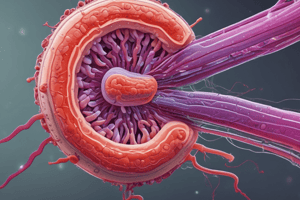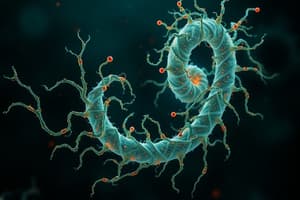Podcast
Questions and Answers
What does the Jarisch-Herxheimer Reaction indicate in patients treated with antibiotics for syphilis?
What does the Jarisch-Herxheimer Reaction indicate in patients treated with antibiotics for syphilis?
- Improved immune response
- Increase in treponemal antibodies
- Adverse drug reaction
- Release of exotoxins (correct)
Which of the following is a confirmatory test for syphilis?
Which of the following is a confirmatory test for syphilis?
- Fluorescent Treponema antibody test
- Microagglutination assay for Treponema pallidum
- VDRL
- Treponemal antibody test (correct)
What stage of Lyme disease is characterized by a papule at the site of a tick bite?
What stage of Lyme disease is characterized by a papule at the site of a tick bite?
- Stage III
- Stage II
- Stage I (correct)
- Latent stage
What is the etiology of Lyme disease?
What is the etiology of Lyme disease?
What is a hallmark symptom of Stage II Lyme disease?
What is a hallmark symptom of Stage II Lyme disease?
Which test is NOT associated with confirming syphilis?
Which test is NOT associated with confirming syphilis?
What condition does chronic Lyme borreliosis indicate?
What condition does chronic Lyme borreliosis indicate?
Which type of serum is used in the process for some syphilis tests?
Which type of serum is used in the process for some syphilis tests?
Which subspecies of Treponema is responsible for yaws?
Which subspecies of Treponema is responsible for yaws?
What is a key characteristic of Treponema bacteria regarding their cultivation?
What is a key characteristic of Treponema bacteria regarding their cultivation?
Which disease is associated with Treponema pallidum subsp. pallidum?
Which disease is associated with Treponema pallidum subsp. pallidum?
What symptom is characterized by a primary lesion known as Mother Yaws?
What symptom is characterized by a primary lesion known as Mother Yaws?
Which condition is caused by Treponema carateum?
Which condition is caused by Treponema carateum?
Which feature best describes Leptospira as mentioned in the content?
Which feature best describes Leptospira as mentioned in the content?
What best defines Tertiary lesions in the context of Treponema infections?
What best defines Tertiary lesions in the context of Treponema infections?
What is a common non-culturable aspect of Treponema bacteria?
What is a common non-culturable aspect of Treponema bacteria?
What is the primary causative agent of pinta?
What is the primary causative agent of pinta?
What are the two recognized species of Leptospira?
What are the two recognized species of Leptospira?
Which stage of syphilis is characterized by dry lesions known as Hard Chancre?
Which stage of syphilis is characterized by dry lesions known as Hard Chancre?
What is the laboratory method used for the diagnosis of syphilis?
What is the laboratory method used for the diagnosis of syphilis?
What condition can result from Leptospira interrogans infection?
What condition can result from Leptospira interrogans infection?
Which of the following tests are considered non-treponemal tests for syphilis diagnosis?
Which of the following tests are considered non-treponemal tests for syphilis diagnosis?
At what stage of syphilis do the lesions known as Condylomata lata appear?
At what stage of syphilis do the lesions known as Condylomata lata appear?
What test utilizes heated serum to identify syphilis?
What test utilizes heated serum to identify syphilis?
How is Leptospira transmitted to humans?
How is Leptospira transmitted to humans?
What can be a sign of severe illness due to Leptospira infection?
What can be a sign of severe illness due to Leptospira infection?
What organism is associated with avian spirochetosis?
What organism is associated with avian spirochetosis?
Which test can be used for laboratory diagnosis of spirochetal infections?
Which test can be used for laboratory diagnosis of spirochetal infections?
Which organism is NOT part of the Mycoplasmataceae family?
Which organism is NOT part of the Mycoplasmataceae family?
What is a characteristic appearance of Mycoplasma hominis in culture?
What is a characteristic appearance of Mycoplasma hominis in culture?
Which condition is associated with Chlamydia trachomatis in men?
Which condition is associated with Chlamydia trachomatis in men?
What is a unique characteristic of Coxiella burnetti among rickettsial pathogens?
What is a unique characteristic of Coxiella burnetti among rickettsial pathogens?
Which laboratory culture method is NOT typically used for Chlamydia psittaci?
Which laboratory culture method is NOT typically used for Chlamydia psittaci?
What is the primary clinical symptom of ureaplasma infections in women?
What is the primary clinical symptom of ureaplasma infections in women?
Which of the following tests is used to identify Chlamydia infections?
Which of the following tests is used to identify Chlamydia infections?
Which characteristic is true of mycoplasmas?
Which characteristic is true of mycoplasmas?
Flashcards are hidden until you start studying
Study Notes
Spirochetes
- Spirochetes are a group of bacteria that are characterized by their long, helical shape.
- They are motile and possess axial fibrils, which are long, flagellum-like intracellular organelles that are responsible for their movement.
- They are facultative anaerobes, meaning they can survive in both oxygen-rich and oxygen-poor environments.
- They are unicellular organisms with a flexible structure.
- They are able to multiply through transverse and binary fission.
Treponema
- Treponema, meaning "turning thread" pertains to the shape of these bacteria.
- T. pallidum subspecies pallidum is the causative agent of syphilis, a sexually transmitted infection (STI) that can cause serious health complications.
- T. pallidum subspecies pertenue causes yaws, a non-STD infection that primarily affects the bones, skin, and joints.
- T. pallidum subspecies endemicum is responsible for endemic syphilis, a less severe form of syphilis primarily affecting the skin, mucous membranes, and lymph nodes.
- T. carateum causes pinta, a non-STD skin infection that leads to skin discoloration.
- Treponema species cannot be cultivated on artificial media.
Syphilis
- The infection manifests in stages: Primary, Secondary, Latent, and Tertiary.
- The primary stage of syphilis is characterized by the development of a painless sore known as a chancre, located in the genitalia.
- The secondary stage involves the appearance of lesions on the body, known as condylomata lata, occurring approximately 2-12 weeks after the development of the primary stage.
- The latent stage shows no sign and is only detected through serological testing.
- The tertiary stage, if untreated, can lead to complications like neurosyphilis and cardiosyphilis.
Laboratory Diagnosis for Treponema
- Laboratory diagnosis of Treponema infections includes:
- Darkfield microscopy
- Special stains such as Levaditi's silver impregnation technique and Fontana-Tribondeau
- Serological tests (Non-treponemal and Treponemal)
Yaws
- Yaws is a chronic, non-STD infection caused by Treponema pallidum subspecies pertenue.
- It is characterized by skin lesions that can involve the bones, skeletal structures, and organs.
- It is also known commonly as Framboise.
- The disease progresses through three stages:
- Primary lesion: Mother Yaws or Framboise
- Secondary lesion: Daughter Yaws
- Tertiary lesion: This stage can lead to severe deformities.
- A crippling form of the disease affecting the feet is known as Crab Yaws.
Carate
- Carate, also known as pinta, is a skin disease caused by Treponema carateum.
- It characterized by hyperpigmented lesions on the skin.
Leptospira
- Leptospira are thin, flexible, and highly motile bacteria that have tightly coiled spirals.
- They are strict aerobes, meaning they require oxygen for survival.
- They possess enzymatic activity, being oxidase, catalase, and peroxidase positive .
- Two species of Leptospira are recognized: Leptospira interrogans and Leptospira biflexa.
- Leptospira are found in the proximal tubules of the kidneys of infected animals and are transmitted through contact with contaminated water or soil.
Weil Disease
- Weil disease, caused by Leptospira, is a severe form of leptospirosis that can lead to renal failure, hepatic failure, and death.
- Leptospira infected animals pass the bacteria in their urine.
- It is characterized by:
- Mild fever to severe illness including jaundice and kidney failure.
Laboratory Diagnosis of Leptospira
- Blood or cerebrospinal fluid (CSF) samples are collected to diagnose Leptospira infection.
- Darkfield microscopy is used for visual identification.
- Fletcher, Stuart, or EMJH (Ellinghausen-McCullough-Johnson-Harris) medium is used for culturing.
- Serological testing is also employed for confirmation.
Borrelia
- Borrelia are loosely coiled, highly flexible spiral-shaped bacteria.
- They are microaerophilic, meaning they can thrive in low-oxygen environments.
- They are visualized using aniline dyes.
- Two notable species:
- Borrelia recurrentis: responsible for relapsing fever, transmitted through human body lice (epidemic relapsing fever), and by ticks (endemic relapsing fever)
- Borrelia burgdorferi: responsible for Lyme disease, transmitted through ticks.
Lyme Disease
- Lyme disease is a multisystemic infection caused by Borrelia burgdorferi sensu lato.
- It is characterized by three stages:
- Stage I: A papule at the site of the tick bite.
- Stage II: Intermittent disease symptoms, resembling infectious mononucleosis (IM), involving the cardiovascular system (CVS) and central nervous system (CNS).
- Stage III: Chronic arthritis and chronic Lyme borreliosis.
Relapsing Fever
- Relapsing fever is caused by Borrelia recurrentis and Borrelia species.
- It is transmitted to humans by human body lice (epidemic relapsing fever) or ticks (endemic relapsing fever).
- The disease is characterized by recurring episodes of fever, chills, and headache.
- Jarisch-Herxheimer reaction occurs in patients treated with antibiotics, leading to an abrupt release of exotoxins causing fever, chills, headache, and myalgia.
Laboratory Diagnosis of Borrelia
- Light microscopy using Giemsa, Wright, Romanowsky, and Leishman-stained blood smears are used for diagnosis.
- Blood picture shows monocytes (monocytosis) and slight anemia.
- Animal inoculation tests are used to confirm the presence of Borrelia.
- Serological testing is also employed.
- Kelley's media A and chick embryo are used for cultivation.
Mycoplasmataceae
- Mycoplasmataceae are pleomorphic, cell wall-deficient bacteria that are slow-growing and highly fastidious (require complex media and conditions).
- They are facultative anaerobes.
- Examples include M. pneumoniae, M. hominis, and U. urealyticum.
- M. hominis has a characteristic fried egg appearance.
Mycoplasma pneumoniae
- M. pneumoniae causes primary atypical pneumonia, which is milder than pneumococcal pneumonia but more frequent.
Mycoplasma Hominis and Ureaplasma Urealyticum
- These two species are implicated in non-gonococcal urethritis.
Chlamydiaceae
- Chlamydiaceae is a group of obligate intracellular parasites that possess characteristics of both bacteria and viruses.
- They are gram-negative.
- Chlamydia species have a cell membrane, contain both DNA and RNA, have prokaryotic ribosomes, and are susceptible to a wide range of antibiotics.
Laboratory Diagnosis of Chlamydia
- Chlamydia infections can be diagnosed through cell culture using McCoy, Hep-2, HeLa, and buffalo green monkey kidney cells.
- Chlamydia psittaci can be cultivated in the yolk sac of embryonated eggs through intraperitoneal inoculation of mice or by inoculation into HeLa 229 cells.
- Chlamydia trachomatis can be inoculated into cell cultures, yolk sacs in mice after intercerebral or intraperitoneal inoculation.
Chlamydia trachomatis
- Chlamydia trachomatis is a common sexually transmitted infection.
- Symptoms in males can range from mild irritation of the penis to discharge, painful urination, swelling of the testicles, eye disease, and arthritis.
- In females, it can cause uncomfortable urination, vaginal discharge, and menstrual disturbances.
Rickettsiaceae
- Rickettsiaceae are small, non-motile, pleomorphic coccobacilli that are obligate intracellular parasites, meaning they require living cells for growth.
- They are gram-negative.
- One exception is Rochalimaea quintana, which can grow in cell-free media.
- Coxiella burnetti is unique amongst rickettsiae due to its resistance to heat, drying, and chemical agents.
Laboratory Diagnosis of Rickettsiaceae
- Stained smears, using Machiavello and Giemsa stains, are used for diagnosis.
- Guinea pigs and mice are used for isolation techniques.
- Serological tests such as neutralization tests, cross-immunity tests, complement fixation tests, and slide and capillary agglutination tests are employed.
- The Weil-Felix test is based on cross-reactions between antibodies in the serum of rickettsial patients.
Studying That Suits You
Use AI to generate personalized quizzes and flashcards to suit your learning preferences.




